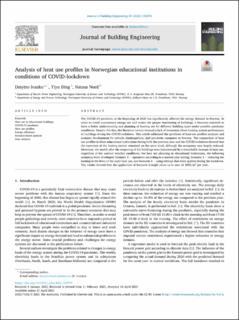| dc.contributor.author | Ivanko, Dmytro | |
| dc.contributor.author | Ding, Yiyu | |
| dc.contributor.author | Nord, Natasa | |
| dc.date.accessioned | 2021-10-25T11:06:24Z | |
| dc.date.available | 2021-10-25T11:06:24Z | |
| dc.date.created | 2021-04-22T13:36:40Z | |
| dc.date.issued | 2021 | |
| dc.identifier.citation | Journal of Building Engineering. 2021, 43, 1-11. | en_US |
| dc.identifier.issn | 2352-7102 | |
| dc.identifier.uri | https://hdl.handle.net/11250/2825313 | |
| dc.description.abstract | The COVID-19 pandemic at the beginning of 2020 has significantly affected the energy demand in Norway. In order to avoid unnecessary energy use and ensure the proper functioning of buildings, it becomes essential to have a better understanding and planning of heating use for different building types under possible pandemic conditions. Despite this fact, the literature review showed a lack of awareness about heating system performance in buildings during the COVID-lockdown. This article addressed the problems of heat use profiles analyses and scenario development for schools, kindergartens, and university campuses in Norway. The comparison of heat use profiles in these educational institutions during both the previous year and the COVID-lockdown showed that the operation of the heating system remained on the same level, although the occupancy was largely reduced. Moreover, the month after the reopening of the buildings was characterized by a remarkable increase in heat use, regardless of the warmer weather conditions. For heat use planning in educational institutions, the following scenarios were developed: Scenario 1 − operation according to a normal year setting; Scenario 2 − reducing the heating to the level of the night heat use; and Scenario 3 − using settings that were applied during the lockdown. The results showed that the application of Scenario 2 might allow us to save 21 kWh/m2 per year. | en_US |
| dc.language.iso | eng | en_US |
| dc.publisher | Elsevier Science | en_US |
| dc.rights | Navngivelse 4.0 Internasjonal | * |
| dc.rights.uri | http://creativecommons.org/licenses/by/4.0/deed.no | * |
| dc.title | Analysis of heat use profiles in Norwegian educational institutions in conditions of COVID-lockdown | en_US |
| dc.type | Peer reviewed | en_US |
| dc.type | Journal article | en_US |
| dc.description.version | publishedVersion | en_US |
| dc.source.pagenumber | 1-11 | en_US |
| dc.source.volume | 43 | en_US |
| dc.source.journal | Journal of Building Engineering | en_US |
| dc.identifier.doi | 10.1016/j.jobe.2021.102576 | |
| dc.identifier.cristin | 1905859 | |
| dc.relation.project | Norges forskningsråd: 267635 | en_US |
| dc.relation.project | Norges forskningsråd: 268248 | en_US |
| cristin.ispublished | true | |
| cristin.fulltext | postprint | |
| cristin.fulltext | original | |
| cristin.qualitycode | 1 | |

